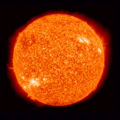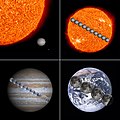File:SolarSystem OrdersOfMagnitude Sun-Jupiter-Earth-Moon-11to3.jpg

Original file (4,010 × 4,010 pixels, file size: 7.13 MB, MIME type: image/jpeg)
Captions
Captions
Summary[edit]
| DescriptionSolarSystem OrdersOfMagnitude Sun-Jupiter-Earth-Moon-11to3.jpg |
English: This image has four quadrants showing relative sizes of four key Solar System objects: the Sun, Jupiter, Earth and the Moon. On the top-left, all four are shown together with sizes to scale. On the top-right, Jupiter is shown to have a diameter ten times smaller (0.10045×) than the diameter of the Sun. On the bottom-left, Jupiter is shown to be eleven times (10.9733×) the diameter of the Earth. Finally on the bottom-right, the Earth is shown to be three and two-thirds (3.6676×) the diameter of the Moon. This is an 11/3 diameter ratio exactly (0.09% error).
The image is titled "Solar System Orders of Magnitude" because of how, generally speaking, the diameter decreases by an order of magnitude when going from the central star, to the gas giants, to the terrestrial planets, down to the moon objects. The fourth image actually shows an unusual situation in the Solar System in that Earth's Moon is closer to its planet's size than other moons are to their planet's size (the Earth-Moon system could actually be considered a double planet). The string of eleven Earth diameters across Jupiter is purposely faded near the Great Red Spot in order to show how the Spot and the Earth have similar diameters. In reference to Jupiter itself, its Red Spot has a diameter that is one order of magnitude smaller than its own diameter. This can be extended to the size relationship of the Sun to Jupiter, that if there were a Giant Sunspot 1/10th of the Sun's diameter, then that Sunspot would have the same diameter as Jupiter. The reason why the bodies are diagrammed at an angle is because their equatorial diameters are larger than their polar diameters, especially for the gas giant, Jupiter. The size ratios depicted here are based upon their average diameters. Also, while it may appear that the bottom-left quadrant shows Jupiter's diameter as slightly smaller than 10.9733 Earth diameters, that is only because a sliver of a crescent of Jupiter is hidden in shadow - the lighting on this image is not 100% "full". NOTE: No effort was made to present the vast distances between any of these bodies to scale. This image was made using GIMP image editing software. |
| Date | |
| Source |
|
| Author | Tdadamemd |
| Other versions |
 SolarSystem OrdersOfMagnitude Sun-Jupiter-Earth-Moon 400x-endless-zoom.gif - Looped gif that zooms in from the Sun down thru Jupiter and Earth down to the Moon, then connecting back to the Sun with similar apparent size. SolarSystem OrdersOfMagnitude Sun-Jupiter-Earth-Moon 400x-endless-zoom.gif - Looped gif that zooms in from the Sun down thru Jupiter and Earth down to the Moon, then connecting back to the Sun with similar apparent size. |
Licensing[edit]
- You are free:
- to share – to copy, distribute and transmit the work
- to remix – to adapt the work
- Under the following conditions:
- attribution – You must give appropriate credit, provide a link to the license, and indicate if changes were made. You may do so in any reasonable manner, but not in any way that suggests the licensor endorses you or your use.
- share alike – If you remix, transform, or build upon the material, you must distribute your contributions under the same or compatible license as the original.
File history
Click on a date/time to view the file as it appeared at that time.
| Date/Time | Thumbnail | Dimensions | User | Comment | |
|---|---|---|---|---|---|
| current | 01:25, 13 January 2013 |  | 4,010 × 4,010 (7.13 MB) | Tdadamemd (talk | contribs) | User created page with UploadWizard |
You cannot overwrite this file.
File usage on Commons
The following 2 pages use this file:
Metadata
This file contains additional information such as Exif metadata which may have been added by the digital camera, scanner, or software program used to create or digitize it. If the file has been modified from its original state, some details such as the timestamp may not fully reflect those of the original file. The timestamp is only as accurate as the clock in the camera, and it may be completely wrong.
| Orientation | Normal |
|---|---|
| Horizontal resolution | 300 dpi |
| Vertical resolution | 300 dpi |
| Software used | GIMP 2.6.11 |
| File change date and time | 19:08, 12 January 2013 |
| Color space | sRGB |
| Image width | 3,000 px |
| Image height | 3,002 px |
| Date and time of digitizing | 08:09, 13 May 2005 |
| Date metadata was last modified | 08:09, 13 May 2005 |

